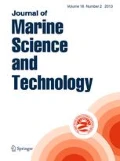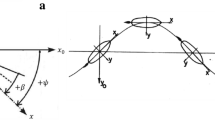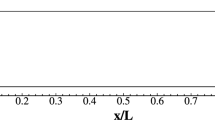Abstract
When the ship speed exceeds a certain level in shallow water, ship-bank interaction induces great influence on the ship’s manoeurability with some special hydrodynamic characteristics, but the mechanism is not totally understood. This paper presents a numerical prediction of the ship-bank interaction for the model of the KRISO Container Ship. An unsteady Reynold-Averaged Navier Stokes solver is applied to simulate the viscous flows. A grid convergence study is performed and the numerical results are compared with the experimental data. The hydrodynamic forces and moments and the squat are computed for different water depths and ship-to-bank distances. Results show that the sway force changes into a repulsive force with respect to the bank under the condition of h = 1.15T or Frh > 0.528 at h = 1.3T, which is due to the change of sway force distribution. The comparison of the results with and without free-surface modelling shows that the wave elevation affects the sway force distribution along the ship significantly. The detailed sway force distributions and wave elevations explain that the wave action between the ship and the bank is the key enabler of the occurrence of the repulsive sway force under the extreme conditions.


















Similar content being viewed by others
References
Celik IB, Ghia U, Roache PJ, Freitas CJ. (2008) Procedure for estimation and reporting of uncertainty due to discretization in CFD applications. J Fluids Eng-Trans ASME 130
Chen XN, Sharma SD (1994) Nonlinear theory of asymmetric motion of a slender ship in a shallow channel. In Twentieth Symposium on Naval Hydrodynamics (pp. 386–407). EP Rood
Ch’ng PW, Doctors LJ, Renilson MR (1993) A method of calculating the ship-bank interaction forces and moments in restricted water. Int Shipbuilding Prog 40(421):7–23
Dand IW (1981) On ship-bank interaction. Trans Royal Inst Naval Arch 124:25–40
Davis J (1986) Hydrodynamic effects of fixed obstacles on ships in shallow water. J Ship Res 30(02):94–102
Gronarz A, Broß H, Mueller-Sampaio C, Jiang T, Thill C (2009) SIMUBIN—Modellierung und Simulation der realitaetsnahen Schiffsbewegungen auf Binnenwasserstraßen (in German). Report 1939 B. Development Centre for Ship Technology and Transport Systems (DST)
Kobyliński L (2014) Bank effect and operation of inland waterways vessels. Zeszyty Naukowe/Akademia Morska w Szczecinie 37(109):50–55
Kaidi S, Smaoui H, Sergent P (2017) Numerical estimation of bank-propeller-hull interaction effect on ship manoeuvring using CFD method. J Hydrodynamics (Ser. B), 158–171
Lataire E, Vantorre M, Delefortrie G (2018) The influence of the ship’s speed and distance to an arbitrarily shaped bank on bank effects. J Offshore Mech Arct Eng 140(2):021304
Lataire E (2014) Experiment-based mathematical modelling of ship bank interaction. Ph.D. Thesis. University of Ghent
Lee S, Hong C (2017) Study on the course stability of very large vessels in shallow water using CFD. Ocean Eng 145:395–405
Lee CK, Lee SG (2008) Investigation of ship maneuvering with hydrodynamic effects between ship and bank. J Mech Sci Technol 22(6):1230–1236
Liu H, Ma N, Gu XC (2020) Uncertainty analysis for ship-bank interaction tests in a circulating water channel. China Ocean Eng 34(3):352–361
Liu Y, Zou L, Lu TC, Zou ZJ (2017) Numerical predictions of hydrodynamic forces and squat of ships in confined waters. 8th International Conference on Computational Methods, ICCM’2017, Guilin, Guangxi, China
Lo DC, Lin IF, Su DT (2009) Applying computational fluid dynamics to simulate bank effect. 19th International Offshore and Polar Engineering Conference. International Society of Offshore and Polar Engineers
Ma SJ, Zou ZJ, Huang LP (2014) A numerical study on bank-effect related hydrodynamics. Maritime Technology and Engineering. Guedes Soares, C., Santos, T.A., ed., Taylor & Francis Group, London, 941–946
Ma Z, Huang SF, Zhu DX (2009) Study on applicability of turbulence model in ship computational fluid dynamics. J Hydrodynamics (Ser. A), 24:85–94 (in Chinese)
Miao Q, Xia J, Chwang A, Duffy JT (2003) Numerical study of bank effects on a ship travelling in a channel. In 8th International Conference on Numerical Ship Hydrodynamics, 1–8
Mucha P, Moctar OE, Dettmann T, Tenzer M (2018) An experimental study on the effect of confined water on resistance and propulsion of an inland waterway ship. Ocean Eng 167:11–22
Mucha P, Moctar OE (2014) Numerical prediction of resistance and squat for a containership in shallow water. Proc 17th Numerical Towing Tank Symposium, Marstrand, Sweden
Mucha P, Deng G, Gourlay T, Moctar OE (2016) Validation studies on numerical prediction of ship squat and resistance in shallow water. Proc 4th International Conference on Ship Manoeuvring in Shallow and Confined Water, MASHCON 2016, Hamburg, Germany. 122–133
Muzaferija S, Peric M, Sames PC, Schellin TE (1988) A two-fluid Navier-Stokes solver to simulate water entry. Symposium on Naval Hydrodynamics
Norrbin NH (1974) Bank effects on a ship moving through a short dredged channel. Proc. 10th Symposium on Naval Hydrodynamics, June 24–28, Cambridge
PIANC, Capability of ship manoeuvring simulation models for approach channels and fairways in harbours (1992). Report of Working Group no. 20 of Permanent Technical Committee II, Supplement to PIANC Bulletin No. 77
Poojari DB, Kar AR (2016) Effect of lateral and depth restriction on ship behavior using computational fluid dynamics, 4th International Conference on Ship Manoeuvring in Shallow and Confined Water, MASHCON 2016, Hamburg, 9–15
Razgallah I, Kaidi S, Smaoui H, Sergent P (2018) The impact of free surface modelling on hydrodynamic forces for ship navigating in inland waterways: water depth, drift angle, and ship speed effect. J Mar Sci Technol 24(2):620–641
Schijf JB (1949) Influence on the form and dimensions of the cross-section of the canal, of the form, of the speed and the propulsion system of vessels. 17th PIANC Section I Inland Navigation, 61–78
Shih TH, Liou WW, Shabbir A, Yang Z, Zhu J (1995) A new κ-ε eddy viscosity model for high reynolds number turbulent flows. Comput Fluids 24(3):227–238
Toxopeus SL, Simonsen CD, Guilmineau E et al (2013) Investigation of water depth and basin wall effects on KVLCC2 in manoeuvring motion using viscous-flow calculations[J]. J Mar Sci Technol 18(4):471–496
Tuck EO (1966) Shallow-water flows past slender bodies. J Fluid Mech 26(1):81–95
Tuck EO, Newman JN (1974) Hydrodynamic interactions between ships. In: 10th Symposium on Naval Hydrodynamics. Office of Naval Research, 35–51
Van Hoydonck W, Toxopeus S, Eloot K, Bhawsinka K, Queutey P, Visonneau M (2019) Bank effects for KVLCC2. J Mar Sci Technol 24(1):174–199
Van Maele K, Merci B (2006) Application of two buoyancy-modified k–ε turbulence models to different types of buoyant plumes. Fire Saf J 41(2):122–138
Vantorre M, Delefortrie G, Eloot K, Laforce E (2003) Experimental investigation of ship-bank interaction forces, Proc International Conference on Marine Simulation and Ship Maneuverability (MARSIM'03), 437–446
Wang HZ, Zou ZJ (2014) Numerical prediction of hydrodynamic forces on a ship passing through a lock. China Ocean Eng 28(3):421–432
Yao JX, Zou ZJ, Wang HM (2011) Numerical study on bank effects for a ship sailing in shallow channel. J Shanghai Jiaotong University (Science) 16(1):91–96
Yasukawa H (1991) Bank Effect on Ship Maneuverability in a Channel with Varying Width, Trans. of the West-Japan Society of Naval Architects, 81: 85–100
Zou L, Larsson L (2013) Computational fluid dynamics (CFD) prediction of bank effects including verification and validation. J Mar Sci Technol 18(3):310–323
Zou L, Zou ZJ, Liu Y (2019) CFD-based predictions of hydrodynamic forces in ship-tug boat interactions. Ships Offshore Struct 14(S1):300–310
Zhou M, Zou Z (2013) Numerical study on the influences of canal geometry on ship squat. Zeszyty Naukowe/Akademia Morska w Szczecinie
Acknowledgements
This study is supported by the State Key Laboratory of Ocean Engineering Independent Research Project: Benchmark study on planar motion mechanism tests and flow field measurement, No. GKZD010077.
Author information
Authors and Affiliations
Corresponding author
Additional information
Publisher's Note
Springer Nature remains neutral with regard to jurisdictional claims in published maps and institutional affiliations.
About this article
Cite this article
Liu, H., Ma, N. & Gu, X. CFD prediction of ship-bank interaction for KCS under extreme conditions. J Mar Sci Technol 26, 1062–1077 (2021). https://doi.org/10.1007/s00773-021-00798-x
Received:
Accepted:
Published:
Issue Date:
DOI: https://doi.org/10.1007/s00773-021-00798-x




